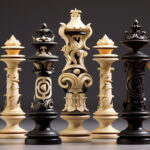Chess is a game of strategy, where players must make calculated moves to advance their position and capture their opponent’s pieces. But the true masters of chess know that tactics are equally important to winning the game. In this article, we’ll take a deep dive into the world of chess tactics and highlight some of the best books on the topic for players of all skill levels.

Understanding Chess Tactics
Before we dive into our book recommendations, let’s take a moment to define what we mean by chess tactics. At its core, tactics refer to the specific moves and techniques that players can use to gain an advantage over their opponents. This might be as simple as a pawn fork, where a pawn attacks two pieces at once, forcing the opponent to choose which piece to defend and allowing the attacker to capture the other.
While chess is often thought of as a game of strategy, tactics play a crucial role in determining the outcome of a game. Even the most strategically sound position can crumble under the pressure of a well-executed tactical maneuver.
More complex tactics might involve sacrifices, where a player intentionally gives up a piece in order to gain a positional advantage. Sacrifices can be especially effective when attacking an opponent’s king or when trying to break through a heavily fortified position.
The Importance of Tactics in Chess
Why are tactics so important in chess? There are several reasons. First, by using tactics effectively, players can gain a material advantage, capturing their opponent’s pieces and putting pressure on their position.
But tactics can also be important for psychological reasons. A well-timed tactic can throw an opponent off their game, forcing them to defend against unexpected threats and disrupting their strategy.
Finally, tactical awareness is a key component of successful chess play. By becoming familiar with the most common tactical patterns and themes, players can anticipate their opponent’s moves and take advantage of any weaknesses in their position.
Key Tactical Concepts and Themes
So what are some of the key tactical concepts that players should be familiar with? Here are a few examples:
- Forks: As mentioned earlier, forks involve attacking two pieces at once with one move. This tactic can be especially effective against pieces that are strategically important or difficult to defend.
- Pins: A pin occurs when a player pins an opponent’s piece against their king, queen, or another valuable piece. This can restrict the opponent’s mobility and make it difficult for them to defend effectively.
- Sacrifices: Sacrifices involve intentionally giving up a piece in order to gain a positional advantage. This can be especially effective when attacking an opponent’s king or when trying to break through a heavily fortified position.
However, these are just a few examples of the many tactical themes and concepts that players may encounter in the game of chess. Other tactical concepts include discovered attacks, double attacks, and deflection.
It’s important to note that tactics are not just about executing flashy moves or sacrificing pieces for the sake of it. Rather, tactics should be used strategically to gain an advantage and ultimately win the game.
The best way to become familiar with these patterns is to study them in depth through books, puzzles, and real-world play. By practicing and honing your tactical skills, you can become a formidable opponent and take your chess game to the next level.
Top Chess Tactics Books for Beginners
Chess is a game that requires a lot of strategy and tactics. If you’re just starting out, it can be overwhelming to try and learn all the different moves and strategies. Luckily, there are many great books available to help beginners learn the basics of chess tactics. Here are a few of our top picks:
“Bobby Fischer Teaches Chess” by Bobby Fischer
Considered a classic in the world of chess, “Bobby Fischer Teaches Chess” is a great introduction to the game for beginners. Written by one of the greatest chess players of all time, this book covers a wide range of topics, including basic tactics, openings, and endgame strategies.
What sets this book apart is Fischer’s clear writing style and emphasis on practical play. He provides numerous examples of how to apply the tactics in real games, making it easy for beginners to understand and follow along. The book also includes a series of puzzles and exercises to help reinforce tactical concepts.
“Chess Tactics for Kids” by Murray Chandler
If you’re looking for a book specifically designed for younger players, “Chess Tactics for Kids” by Murray Chandler is a great option. The book is filled with colorful illustrations and diagrams to help make the concepts clear and understandable.
Chandler introduces a variety of tactical themes, including pins, forks, and double attacks. He also includes helpful tips on how to spot and defend against these tactics. The book includes a useful glossary of chess terms and a series of puzzles for young readers to solve.
“Winning Chess Tactics” by Yasser Seirawan
For players who are looking for a more in-depth introduction to chess tactics, “Winning Chess Tactics” by Yasser Seirawan is a great option. The book covers a wide range of topics, from basic tactics to advanced combinations.
Seirawan’s clear writing style and focus on practical play make this book accessible to players of all skill levels. He provides detailed explanations of each tactic, as well as examples of how to apply them in real games. The book also includes numerous puzzles and exercises to help reinforce the concepts.
No matter which book you choose, remember that learning chess tactics takes time and practice. It’s important to study the concepts carefully and try to apply them in your own games. With patience and dedication, you’ll soon be on your way to becoming a skilled chess player.
Best Intermediate Chess Tactics Books
For players who have already mastered the basics of chess tactics and are looking to take their game to the next level, there are several books that are particularly helpful. Here are a few of our top picks:
“Tactics Time!” by Tim Brennan and Anthea Carson
“Tactics Time!” is a collection of over 1,000 chess puzzles designed to challenge and improve players’ tactical skills. The book covers a wide range of tactical themes, from simple forks and pins to complex combinations.
The authors provide clear explanations for each puzzle solution, making this book ideal for players who are looking to strengthen their tactical understanding and improve their overall game.
One of the great things about “Tactics Time!” is that it is organized by theme, making it easy for players to focus on specific areas of their game that need improvement. For example, if a player is struggling with pins, they can turn to the section on pins and work through the puzzles in that section until they feel more confident in their ability to recognize and exploit pinning opportunities.
Another helpful feature of “Tactics Time!” is that the puzzles are arranged in order of increasing difficulty, so players can gradually build their skills and confidence as they work through the book.
“The Art of Chess Combination” by Eugene Znosko-Borovsky
First published in 1959, “The Art of Chess Combination” remains a classic guide to the game of chess. The book focuses on the art of combination play, where players use tactical themes and motifs to create powerful attacks on their opponents.
Znosko-Borovsky provides numerous examples of combinations from both classic and modern chess games, and includes detailed explanations of the underlying tactical themes. The book also includes a series of puzzles and exercises to help readers reinforce their understanding of the concepts.
One of the strengths of “The Art of Chess Combination” is that it emphasizes the importance of creativity and imagination in chess. Znosko-Borovsky encourages readers to experiment with different tactical ideas and to develop their own unique style of play.
Another valuable aspect of the book is its focus on the psychological aspects of chess. Znosko-Borovsky explains how players can use combinations to unsettle their opponents and gain a psychological advantage, which can be just as important as a material advantage on the board.
“Chess Tactics from Scratch” by Martin Weteschnik
“Chess Tactics from Scratch” is a comprehensive guide to chess tactics, designed for players of all skill levels. The book covers a wide range of tactical themes and motifs, from simple forks and pins to complex combinations and sacrifices.
Weteschnik provides clear explanations for each concept and includes numerous examples and puzzles to help readers reinforce their understanding. The book also includes a series of quizzes and tests to help players track their progress.
One of the unique features of “Chess Tactics from Scratch” is that it includes a section on the psychology of tactics. Weteschnik explains how players can use tactical ideas to create uncertainty and confusion in their opponents, and how to avoid falling into traps and pitfalls set by their opponents.
Another valuable aspect of the book is its emphasis on pattern recognition. Weteschnik shows how many tactical motifs recur in different types of positions, and how players can use this knowledge to quickly identify and exploit tactical opportunities.
Overall, “Chess Tactics from Scratch” is an excellent resource for players who are serious about improving their tactical skills and taking their game to the next level.
Advanced Chess Tactics Books for Experts
For players who have already mastered the basics and are looking for more advanced tactical concepts, there are several books that are particularly helpful. Here are a few of our top picks:
“Imagination in Chess” by Paata Gaprindashvili
“Imagination in Chess” is a collection of advanced puzzles and combinations, designed to challenge even the most experienced players. The book covers a wide range of tactical themes, from double and triple attacks to positional sacrifices.
Gaprindashvili provides clear explanations for each puzzle and includes numerous examples from both classic and modern chess games. The book also includes a series of tests and quizzes to help readers reinforce their understanding of the concepts.
“Advanced Chess Tactics” by Lev Psakhis
“Advanced Chess Tactics” is a comprehensive guide to advanced tactical concepts, designed for players who are already familiar with the basics. The book covers a wide range of themes, including attacking the king, positional sacrifices, and unexpected combinations.
Psakhis provides clear explanations and numerous examples for each concept, along with a series of exercises and tests to help reinforce the concepts. The book also includes a chapter on psychological factors in chess, such as time pressure and decision-making under stress.
“The Complete Manual of Positional Chess” by Sakaev and Landa
Although not strictly a tactics book, “The Complete Manual of Positional Chess” is an essential guide to the game for advanced players. The book covers a wide range of positional themes, such as pawn structure, piece placement, and strategic planning.
By understanding these positional concepts, players can anticipate their opponent’s moves and set up tactical opportunities. The book also includes numerous examples and exercises to help readers reinforce their understanding of the concepts.
Conclusion
Whether you’re a beginner or an experienced player, studying chess tactics is an essential component of success in the game. By becoming familiar with the most common tactical themes and motifs, players can anticipate their opponent’s moves and take advantage of any weaknesses in their position.
The books recommended in this article are just a few of the many resources available to players looking to improve their tactical understanding. By incorporating these books into your study regimen and practicing the concepts through puzzles and real-world play, you can take your chess game to the next level.
FAQs
Is playing chess good for your brain?
Studies show that playing chess and other strategic and problem-solving games can help reduce your chances of developing dementia. Keeping your brain busy, even through games like chess, can have major benefits.
Is there a strategy to help you win chess every time?
There are many studies that have been done that highlight different methods and strategies to adopt to help you win chess every time. However, due to the unpredictability of the game and the players, you cannot implement one rule that will ensure victory every time.
- The 11 Best Books About Cats You Should Read - January 16, 2024
- The 9 Best Books on Building Confidence - January 16, 2024
- Discover the 10 Best Books on the Brain - January 16, 2024









